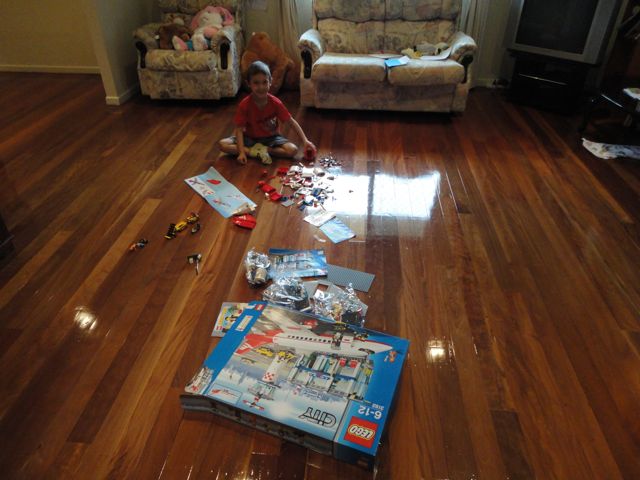
Buying gifts is difficult, except for my 6 year old son, for whom buying LEGO is guaranteed to please. We recently purchased a set for his birthday and he set about putting it together almost immediately. A set such as the one pictured below (which costs about $50 in Australia when on sale) will take him a couple of hours to put together, with minimal parental assistance. This is an opportunity for the rest of us to enjoy some relative peace, so you might say that it pays dividends straight away!
This got me to thinking about the relative merits and shortcomings of LEGO (and similar construction sets). It is easy to sing its praises. No doubt it helps children to develop their visuospatial skills (hey, even I find those instructions rather difficult to follow!), hand-eye coordination and attention span.
Although it is largely a solo activity, we can share it in the sense that if he is having difficulty finding or assembling pieces, or if he has assembled parts incorrectly, then I will lend assistance. His younger sister would like to help to, but he is not much interested in her input. To be blunt, from a sibling perspective, LEGO is an exclusive rather than collaborative activity. Even so, I hope that when my son looks back on his childhood, he may have faint memories of the two of us putting those blocks together … together.
As a boardgamer, I am always interested in quantifying the hours of entertainment gained per dollar spent. On that score, I would say that the replayability of LEGO is low, but similar to most other toys (perhaps it is inherently unfair to try to compare toys to boardgames on this metric). Once construction is complete, my son will rarely take it apart to relive the joy of putting it together again. He will return to play with the completed models occasionally, but probably less often than he will play with other toys, such as train sets and action figures.
One key question for me is: does LEGO allow children to develop and express their imagination? I doubt this very much, at least based on my experience with various boxed sets that, if anything, are quite prescriptive about how to use the blocks to assemble the models depicted on the box. But I do not believe that the value of LEGO lies in imagination. Rather, its value is in giving a child an opportunity to complete a project and clear instructions on how to do so, such that when it is done they can bask in a sense of accomplishment.
Perhaps your experience with LEGO is very different; if so I would like to hear about it. It would not surprise me to hear that my children and I are “doing it wrong”!





I think part of the issue is both how detailed the sets are these days. When I was a kid, my friends and I would all get together with our LEGOs, build up whatever wacky spaceships we could imagine (we all collected space series LEGOs) and duke it out. I may have had one set with instructions, but I don’t know that I ever actually followed them. My 8 year old, on the other hand, just got a LEGO Star Destroyer for his Birthday, which was complex enough that we’re treating it like a puzzle. (put it together, enjoy it for a bit, take it apart and return to box, repeat as interested) Quite frankly, some of these pieces are so specific that it makes no sense to mix them up with the rest of his LEGOs. Mine were so much more generic, and if I recall correctly, the sets always were designed to allow you to build multiple things.
Thanks Luis. Like you, I had one mega-collection of LEGO as a child, and if there were any instructions originally, they were lost long before I can remember. The pieces were almost all the most basic blocks; I did not acquire a set with wheels and special connectors until I was a teenager.
Like your son, my son has distinct sets of LEGO that are best kept separate from one another.
Wow, my little geeks are a complete 180 when it comes to LEGO. They actually avoid the instructions on how to make things and go off and make their own creations. I personally find LEGOs to be an outstanding medium in which to express your creativity.
There is a growing list of LEGO board games if you want to bridge that gap between “toy” and “board game”. In fact, we recently reviewed Minotaurus, for example, that does just that.
LEGO is one of those interesting toys that have unlimited potential. The kids have to put all the work into it, as LEGO is simply a medium. Much like a clump of colorful clay. In itself, nothing, but with a little imagination, something extraordinary is always created.
No doubt they take after their father … as though that’s a GOOD thing.
No Christmas bonus for you, Meng….